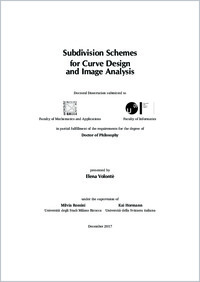Subdivision schemes for curve design and image analysis
- Volontè, Elena
- Hormann, Kai (Degree supervisor)
- Rossini, Milvia (Degree committee member)
-
18.01.2018
182 p
Thèse de doctorat: Università della Svizzera italiana, 2018
Subdivision schemes
Non-linear subdivision schemes
Curvature
G^2 continuity
Multiple multiresolution analysis
Multiple subdivision scheme
Shearlets
Filterbanks
English
Subdivision schemes are able to produce functions, which are smooth up to pixel accuracy, in a few steps through an iterative process. They take as input a coarse control polygon and iteratively generate new points using some algebraic or geometric rules. Therefore, they are a powerful tool for creating and displaying functions, in particular in computer graphics, computer-aided design, and signal analysis. A lot of research on univariate subdivision schemes is concerned with the convergence and the smoothness of the limit curve, especially for schemes where the new points are a linear combination of points from the previous iteration. Much less is known for non-linear schemes: in many cases there are only ad hoc proofs or numerical evidence about the regularity of these schemes. For schemes that use a geometric construction, it could be interesting to study the continuity of geometric entities. Dyn and Hormann propose sufficient conditions such that the subdivision process converges and the limit curve is tangent continuous. These conditions can be satisfied by any interpolatory scheme and they depend only on edge lengths and angles. The goal of my work is to generalize these conditions and to find a sufficient constraint, which guarantees that a generic interpolatory subdivision scheme gives limit curves with continuous curvature. To require the continuity of the curvature it seems natural to come up with a condition that depends on the difference of curvatures of neighbouring circles. The proof of the proposed condition is not completed, but we give a numerical evidence of it. A key feature of subdivision schemes is that they can be used in different fields of approximation theory. Due to their well-known relation with multiresolution analysis they can be exploited also in image analysis. In fact, subdivision schemes allow for an efficient computation of the wavelet transform using the filterbank. One current issue in signal processing is the analysis of anisotropic signals. Shearlet transforms allow to do it using the concept of multiple subdivision schemes. One drawback, however, is the big number of filters needed for analysing the signal given. The number of filters is related to the determinant of the expanding matrix considered. Therefore, a part of my work is devoted to find expanding matrices that give a smaller number of filters compared to the shearlet case. We present a family of anisotropic matrices for any dimension d with smaller determinant than shearlets. At the same time, these matrices allow for the definition of a valid directional transform and associated multiple subdivision schemes.
- Language
-
- English
- Classification
- Computer science and technology
- License
-
License undefined
- Identifiers
-
- RERO DOC 306682
- URN urn:nbn:ch:rero-006-116880
- ARK ark:/12658/srd1318743
- Persistent URL
- https://n2t.net/ark:/12658/srd1318743
Statistics
Document views: 376
File downloads:
- Texte intégral: 476
